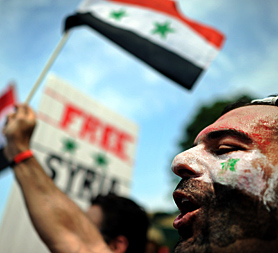Syrian army hits Hama hard and fast
Syrian Special Forces and tanks are battling to wrest back control of Hama, reports defence analyst Anthony Tucker-Jones.

Heavy shelling and air strikes heralded President Bashir’s determination to snuff out the opposition in the city of Hama in the early hours of 31 July.
Fearing the four month old rebellion will spread during the holy month of Ramadan the Syrian Army launched this attack as a pre-emptive operation.
The defiant city has effectively been under a state of siege for the past month. Built on the Orontes River it sits on the strategic north-south highway and dominates routes west to the Syria coast and the port of Latakia.
In rebel hands Hama acts as a barrier to Syria’s second largest city Aleppo to the north and the capital Damascus to the south.
In addition Hama is reportedly one of five key locations that have been involved in the production of chemical weapons.
During the opening shelling on the 31st Syrian gunners and fighter-bombers sought to silence rebel strongpoints. In the wake of this bombardment came the Al-Wahdat al-Khassa or Special Forces backed by tanks.
Read more: Syria's defiant women vow to keep up the fight
President Bashir is able to call on some of the strongest and most combat experienced commando units in the world thanks to years of fighting in Lebanon.
The attack on Hama was undoubtedly spearheaded by elements of the 14th Special Forces Division (which can call on up to eight special forces regiments), the Rapid Deployment Brigade and the Saraya al Difa (Defence Companies).
At dawn Syrian Commandos bearing the distinctive tiger head badge moved into Hama to protect the tanks moving up to smash make shift barricades erected by the residents.
FIBUA or fighting in built-up areas is always a risky business for armoured vehicles and the commandos swiftly secured key road junctions and the river crossings to ensure there were no nasty surprises for the tanks crews.
They also conducted snatch operations with a view to seizing or even liquidating rebel ringleaders who had been identified by the Syrian Mukhabarat intelligence service.
The key crossings over the Orontes lay beneath the old Citadel, by the An-Nuri Mosque and opposite the Sharia al-Buhturi boulevard.
In pacifying the city the Syrian Army has its work cut out occupying the Citadel, Old Town and souk area if the rebels refuse to melt away and choose to make a stand there or launch guerrilla attacks.
Reports indicate that the rebels were resisting using small arms and that the key postal and telecomms buildings along the Sahria al-Quwatli had come under fire and that the city’s police stations were burning.
There seems to have been nothing subtle or surgical with the Syrian Army’s move in to Hama. Tanks and other armoured fighting vehicles occupied all the key open spaces, then after killing around 140 of the city’s inhabitants and losing five men the Syrian Army withdrew before nightfall.
This withdrawal signals that the Syrian forces are not confident that they can dominate the ground they occupied. It may also indicate a lack of confidence in their night fighting capabilities.
The attack on Hama echoes earlier bloody assaults on the country’s key cities, most notably on Jisr al-Shughour in mid-June, which witnessed the deployment of 15,000 troops and elements of an armoured division.
Unlike Colonel Gaddafi‘s increasingly precarious position in Libya, President Bashir remains firmly entrenched in Syria with a powerful and competent military prepared to do his bidding.
It seems he has chosen to make an example of Hama.
Anthony Tucker-Jones is the security and terrorism correspondent for “intersec – The Journal of International Security” as well as a regular commentator for defencemanagement.com